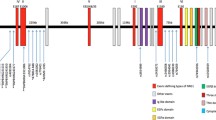Abstract
Thrombospondin 1 (THBS1), a multi-domain glycoprotein, is secreted from astrocytes and promotes synaptogenesis. Increasing evidence has suggested that not only various markers for synaptic pathology, but also astrocytes are affected in schizophrenia. In this study, we investigated whether coding region single nucleotide polymorphisms (cSNPs) of the THBS1 gene were associated with schizophrenia and with the clinical symptoms of schizophrenia patients. We genotyped two cSNPs [rs2228261 (Asn470Asn) and rs2292305 (Thr523Ala)] using direct sequencing in 220 schizophrenia patients and 376 control subjects. In this study, rs2228261 revealed significant association with schizophrenia in both codominant (TT vs. CC, P = 0.009, OR = 2.10, 95% CI = 1.23–3.59) and recessive models (TT vs. CC/CT, P = 0.0012, OR = 2.28, 95% CI = 1.38–3.77). Also, rs2292305 was associated with schizophrenia in the recessive model (GG vs. AA/AG, P = 0.0052, OR = 2.05, 95% CI = 1.24–3.38). Additionally, in the analysis of the haplotype, the CA and TG haplotypes consisting of rs2228261 and rs2292305 were associated with schizophrenia in the dominant (P = 0.019, OR = 1.79, 95% CI = 1.10–2.90) and recessive models, respectively (P = 0.0086, OR = 0.51, 95% CI = 0.31–0.84). In further analysis according to the clinical symptoms, rs2292305 showed a weak association with the poor concentration symptoms of schizophrenia patients in the dominant model (AG/GG vs. AA, P = 0.024, OR = 2.04, 95% CI = 1.09–3.83). The results suggest that the THBS1 gene may contribute to the susceptibility of schizophrenia.
Similar content being viewed by others
References
Webster MJ, O’Grady J, Kleinman JE, Weickert CS (2005) Glial fibrillary acidic protein mRNA levels in the cingulate cortex of individuals with depression, bipolar disorder and schizophrenia. Neuroscience 133:453–461
Bruneau EG, McCullumsmith RE, Haroutunian V, Davis KL, Meador-Woodruff JH (2005) Increased expression of glutaminase and glutamine synthetase mRNA in the thalamus in schizophrenia. Schizophr Res 75:27–34
Katsel P, Byne W, Roussos P et al (2011) Astrocyte and glutamate markers in the superficial, deep, and white matter layer of the anterior cingulate gyrus in schizophrenia. Neuropsychopharmacology 36:1171–1177
Bernstein HG, Steiner J, Bogerts B (2009) Glial cells in schizophrenia: pathophysiological significance and possible consequences for therapy. Expert Rev Neurother 9:1059–1071
Adams JC, Lawler J (2004) The thrombospondins. Int J Biochem Cell Biol 6:961–968
Bornstein P (2001) Thrombospondins as matricellular modulators of cell function. J Clin Invest 107:929–934
Bornstein P, Agah A, Kyriakides TR (2004) The role of thrombospondins 1 and 2 in the regulation of cell-matrix interactions, collagen fibril formation, and the response to injury. Int J Biochem Cell Biol 36:1115–1125
Kyriakides TR, Rojnuckarin P, Reidy MA et al (2003) Megakaryocytes require thrombospondin-2 for normal platelet formation and function. Blood 101:3915–3923
Lin TN, Kim GM, Chen JJ et al (2003) Differential regulation of thrombospondin-1 and thrombospondin-2 after focal cerebral ischemia/reperfusion. Stroke 34:177–186
Tran MD, Neary JT (2006) Purinergic signaling induces thrombospondin-1 expression in astrocytes. Proc Natl Acad Sci USA 103:9321–9326
Yonezawa T, Hattori S, Inagaki J et al (2010) Type IV collagen induces expression of thrombospondin-1 that is mediated by integrin α1β1 in astrocytes. Glia 58:755–767
Christopherson KS, Ullian EM, Stokes CC (2005) Thrombospondins are astrocyte-secreted proteins that promote CNS synaptogenesis. Cell 120:421–433
Stober G, Saar K, Ruschendorf F et al (2000) Splitting schizophrenia: periodic catatonia-susceptibility locus on chromosome 15q15. Am J Hum Genet 67:1201–1207
Küry S, Rubie C, Moisan JP, Stöber G (2003) Mutation analysis of the zinc transporter gene SLC30A4 reveals no association with periodic catatonia on chromosome 15q15. J Neural Transm 110:1329–1332
Moon HJ, Yim SV, Lee WK et al (2006) Identification of DNA copy-number aberrations by array-comparative genomic hybridization in patients with schizophrenia. Biochem Biophys Res Commun 344:531–539
American Psychiatric Association (1994) Diagnostic and Statistical Manual of Mental Disorders, 4th edn. American Psychiatric Press, Washington DC
McGuffin P, Farmer A, Harvey I (1991) A polydiagnostic application of operational criteria in studies of psychotic illness. Development and reliability of the OPCRIT system. Arch Gen Psychiatry 48:764–770
Fanous AH, van den Oord EJ, Riley BP et al (2005) Relationship between a high-risk haplotype in the DTNBP1 (dysbindin) gene and clinical features of schizophrenia. Am J Psychiatry 162:1824–1832
Dikeos DG, Wickham H, McDonald C et al (2006) Distribution of symptom dimensions across Kraepelinian divisions. Br J Psychiatry 189:346–353
Gabriel SB, Schaffner SF, Nguyen H et al (2002) The structure of haplotype blocks in the human genome. Science 296:2225–2229
Garcia O, Torres M, Helguera P, Coskun P, Busciglio J (2010) A Role for thrombospondin-1 deficits in astrocyte-mediated spine and synaptic pathology in Down’s syndrome. PLoS One 5:e14200
Demirhan O, Tastemir C (2003) Chromosome aberrations in a schizophrenia population. Schizophr Res 65:1–7
Mantry D, Cooper SA, Smiley E et al (2008) The prevalence and incidence of mental ill-health in adults with Down syndrome. J Intellect Disabil Res 52:141–155
Serre D, Gurd S, Ge B et al (2008) Differential allelic expression in the human genome: a robust approach to identify genetic and epigenetic cis-acting mechanisms regulating gene expression. PLoS Genet 4:e1000006
Acknowledgment
This work was supported by a grant from the Kyung Hee University in 2011 (KHU- 20110061).
Author information
Authors and Affiliations
Corresponding author
Rights and permissions
About this article
Cite this article
Park, H.J., Kim, S.K., Kim, J.W. et al. Association of thrombospondin 1 gene with schizophrenia in Korean population. Mol Biol Rep 39, 6875–6880 (2012). https://doi.org/10.1007/s11033-012-1513-3
Received:
Accepted:
Published:
Issue Date:
DOI: https://doi.org/10.1007/s11033-012-1513-3



